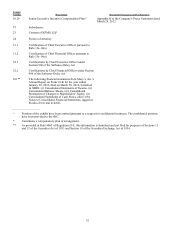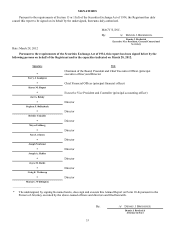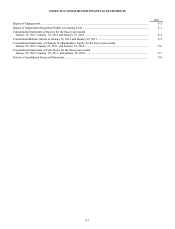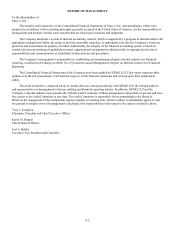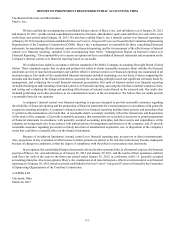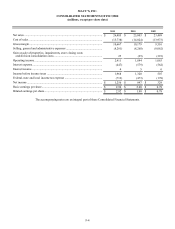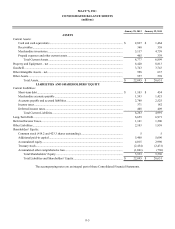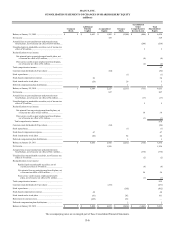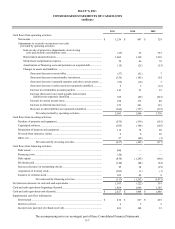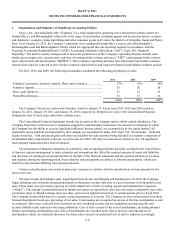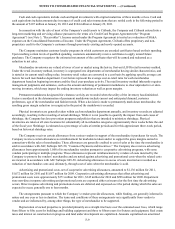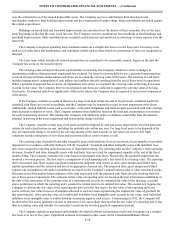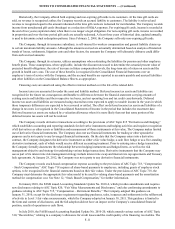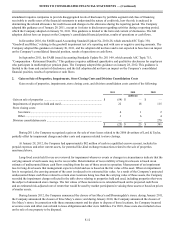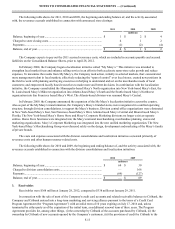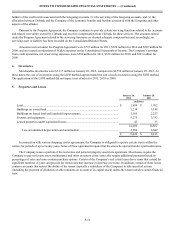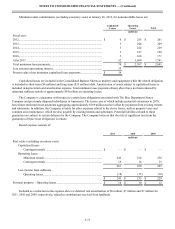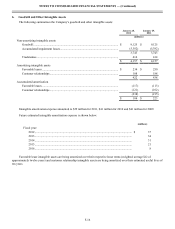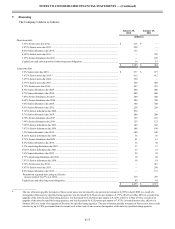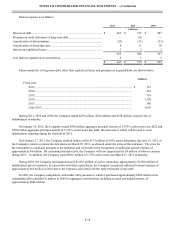Macy's 2011 Annual Report Download - page 48
Download and view the complete annual report
Please find page 48 of the 2011 Macy's annual report below. You can navigate through the pages in the report by either clicking on the pages listed below, or by using the keyword search tool below to find specific information within the annual report.
F-8
MACY’S, INC.
NOTES TO CONSOLIDATED FINANCIAL STATEMENTS
1. Organization and Summary of Significant Accounting Policies
Macy’s, Inc. and subsidiaries (the “Company”) is a retail organization operating stores and Internet websites under two
brands (Macy’s and Bloomingdale’s) that sell a wide range of merchandise, including apparel and accessories (men's, women's
and children's), cosmetics, home furnishings and other consumer goods in 45 states, the District of Columbia, Guam and Puerto
Rico. As of January 28, 2012, the Company’s operations were conducted through Macy’s, macys.com, Bloomingdale’s,
bloomingdales.com and Bloomingdale’s Outlet, which are aggregated into one reporting segment in accordance with the
Financial Accounting Standards Board (“FASB”) Accounting Standards Codification (“ASC”) Topic 280, “Segment
Reporting.” The metrics used by management to assess the performance of the Company’s operating divisions include sales
trends, gross margin rates, expense rates, and rates of earnings before interest and taxes (“EBIT”) and earnings before interest,
taxes, depreciation and amortization (“EBITDA”). The Company’s operating divisions have historically had similar economic
characteristics and are expected to have similar economic characteristics and long-term financial performance in future periods.
For 2011, 2010 and 2009, the following merchandise constituted the following percentages of sales:
2011 2010 2009
Feminine Accessories, Intimate Apparel, Shoes and Cosmetics..................... 37% 36% 36%
Feminine Apparel............................................................................................ 25 26 26
Men’s and Children’s...................................................................................... 23 23 22
Home/Miscellaneous....................................................................................... 15 15 16
100% 100% 100%
The Company’s fiscal year ends on the Saturday closest to January 31. Fiscal years 2011, 2010 and 2009 ended on
January 28, 2012, January 29, 2011 and January 30, 2010, respectively. References to years in the Consolidated Financial
Statements relate to fiscal years rather than calendar years.
The Consolidated Financial Statements include the accounts of the Company and its wholly-owned subsidiaries. The
Company from time to time invests in companies engaged in complementary businesses. Investments in companies in which
the Company has the ability to exercise significant influence, but not control, are accounted for by the equity method. All
marketable equity and debt securities held by the Company are accounted for under ASC Topic 320, “Investments – Debt and
Equity Securities,” with unrealized gains and losses on available-for-sale securities being included as a separate component of
accumulated other comprehensive income, net of income tax effect. All other investments are carried at cost. All significant
intercompany transactions have been eliminated.
The preparation of financial statements in conformity with accounting principles generally accepted in the United States
of America requires management to make estimates and assumptions that affect the reported amounts of assets and liabilities
and disclosure of contingent assets and liabilities at the date of the financial statements and the reported amounts of revenues
and expenses during the reporting period. Such estimates and assumptions are subject to inherent uncertainties, which may
result in actual amounts differing from reported amounts.
Certain reclassifications were made to prior years’ amounts to conform with the classifications of such amounts for the
most recent year.
Net sales include merchandise sales, leased department income and shipping and handling fees. In 2010, the Company
began including sales of private brand goods directly to third party retailers and sales of excess inventory to third parties in net
sales. These items were previously reported, net of the related cost of sales, in selling, general and administrative expenses
(“SG&A”). This change in presentation had an immaterial impact on reported net sales, does not impact comparable store sales,
net income (loss) or diluted earnings (loss) per share, and was not applied retroactively to annual periods prior to fiscal 2010.
The Company licenses third parties to operate certain departments in its stores. The Company receives commissions from these
licensed departments based on a percentage of net sales. Commissions are recognized as income at the time merchandise is sold
to customers. Sales taxes collected from customers are not considered revenue and are included in accounts payable and
accrued liabilities until remitted to the taxing authorities. Cost of sales consists of the cost of merchandise, including inbound
freight, and shipping and handling costs. Sales of merchandise are recorded at the time of delivery and reported net of
merchandise returns. An estimated allowance for future sales returns is recorded and cost of sales is adjusted accordingly.


